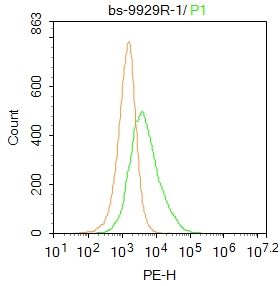KCNE1L Polyclonal Antibody
Purified Rabbit Polyclonal Antibody (Pab)
- SPECIFICATION
- CITATIONS
- PROTOCOLS
- BACKGROUND

Application
| WB, IHC-P, IHC-F, IF, E |
|---|---|
| Primary Accession | Q9UJ90 |
| Reactivity | Rat, Pig, Bovine |
| Host | Rabbit |
| Clonality | Polyclonal |
| Calculated MW | 15 KDa |
| Physical State | Liquid |
| Immunogen | KLH conjugated synthetic peptide derived from human KCNE1L |
| Epitope Specificity | 11-110/142 |
| Isotype | IgG |
| Purity | affinity purified by Protein A |
| Buffer | 0.01M TBS (pH7.4) with 1% BSA, 0.02% Proclin300 and 50% Glycerol. |
| SUBCELLULAR LOCATION | Plasma membrane; Single-pass type I membrane protein. |
| SIMILARITY | Belongs to the potassium channel KCNE family. |
| DISEASE | Defects in KCNE1L are involved in Alport syndrome with mental retardation midface hypoplasia and elliptocytosis (ATS-MR) [MIM:300194]. A X-linked contiguous gene deletion syndrome characterized by glomerulonephritis, deafness, mental retardation, midface hypoplasia and elliptocytosis. |
| Important Note | This product as supplied is intended for research use only, not for use in human, therapeutic or diagnostic applications. |
| Background Descriptions | KCNE1L belongs to the potassium channel KCNE family which represent the most complex class of voltage-gated ion channels from both functional and structural standpoints. Their diverse functions include regulating neurotransmitter release, heart rate, insulin secretion, neuronal excitability, epithelial electrolyte transport, smooth muscle contraction, and cell volume. |
| Gene ID | 23630 |
|---|---|
| Other Names | Potassium voltage-gated channel subfamily E regulatory beta subunit 5, AMME syndrome candidate gene 2 protein, Potassium channel subunit beta MiRP4, Potassium voltage-gated channel subfamily E member 1-like protein, KCNE5, AMMECR2, KCNE1L {ECO:0000303|PubMed:10493825} |
| Target/Specificity | Highly expressed in heart, skeletal muscle, brain, spinal cord and placenta. |
| Dilution | WB=1:500-2000,IHC-P=1:100-500,IHC-F=1:100-500,IF=1:50-200,Flow-Cyt=1ug/test,ELISA=1:5000-10000 |
| Storage | Store at -20 ℃ for one year. Avoid repeated freeze/thaw cycles. When reconstituted in sterile pH 7.4 0.01M PBS or diluent of antibody the antibody is stable for at least two weeks at 2-4 ℃. |
| Name | KCNE5 |
|---|---|
| Synonyms | AMMECR2, KCNE1L {ECO:0000303|PubMed:1049 |
| Function | Potassium channel ancillary subunit that is essential for generation of some native K(+) currents by virtue of formation of heteromeric ion channel complex with voltage-gated potassium (Kv) channel pore-forming alpha subunits. Functions as an inhibitory beta- subunit of the repolarizing cardiac potassium ion channel KCNQ1. |
| Cellular Location | Membrane; Single- pass type I membrane protein |
| Tissue Location | Highly expressed in heart, skeletal muscle, brain, spinal cord and placenta. |

Thousands of laboratories across the world have published research that depended on the performance of antibodies from Abcepta to advance their research. Check out links to articles that cite our products in major peer-reviewed journals, organized by research category.
info@abcepta.com, and receive a free "I Love Antibodies" mug.
Provided below are standard protocols that you may find useful for product applications.
If you have used an Abcepta product and would like to share how it has performed, please click on the "Submit Review" button and provide the requested information. Our staff will examine and post your review and contact you if needed.
If you have any additional inquiries please email technical services at tech@abcepta.com.













 Foundational characteristics of cancer include proliferation, angiogenesis, migration, evasion of apoptosis, and cellular immortality. Find key markers for these cellular processes and antibodies to detect them.
Foundational characteristics of cancer include proliferation, angiogenesis, migration, evasion of apoptosis, and cellular immortality. Find key markers for these cellular processes and antibodies to detect them. The SUMOplot™ Analysis Program predicts and scores sumoylation sites in your protein. SUMOylation is a post-translational modification involved in various cellular processes, such as nuclear-cytosolic transport, transcriptional regulation, apoptosis, protein stability, response to stress, and progression through the cell cycle.
The SUMOplot™ Analysis Program predicts and scores sumoylation sites in your protein. SUMOylation is a post-translational modification involved in various cellular processes, such as nuclear-cytosolic transport, transcriptional regulation, apoptosis, protein stability, response to stress, and progression through the cell cycle. The Autophagy Receptor Motif Plotter predicts and scores autophagy receptor binding sites in your protein. Identifying proteins connected to this pathway is critical to understanding the role of autophagy in physiological as well as pathological processes such as development, differentiation, neurodegenerative diseases, stress, infection, and cancer.
The Autophagy Receptor Motif Plotter predicts and scores autophagy receptor binding sites in your protein. Identifying proteins connected to this pathway is critical to understanding the role of autophagy in physiological as well as pathological processes such as development, differentiation, neurodegenerative diseases, stress, infection, and cancer.


